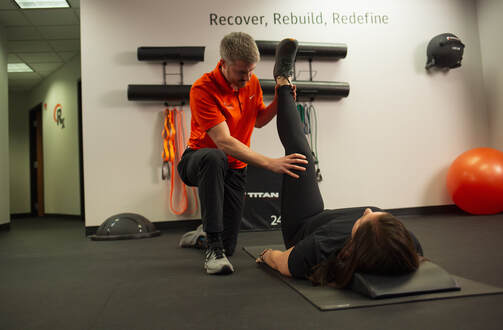Hip Pain
Is pain in your hip making it hard to lift weights, run, jump, squat, climb stairs, get up from a low seat, sleep, or perform your normal work or home duties?
Does this sound like you?
- You thought the pain would go away in a few days or weeks, but it didn't?
- You tried heating pads, ice, and home TENS units but they did nothing?
- You had a few massages, but the pain just came back in a few days?
- You went to a doctor who took some images and gave you an injection or told you to take some pills, but the relief didn't last?
- You tried physical therapy in the past but it didn't help?
- You decided that if you just avoid the activities that hurt, you can live with it?
We are here to help you find long term solutions!


Typical Hip Conditions we Treat:
- Arthritis
- Labral Tears
- Joint Instability
- Hamstring Strains
- Femoroacetabuar Impingement
- Hip Flexor Tendinopathy
- Iliotibial Band (IT Band) Syndrome
- Pre/Post-Op Total Hip Replacement
Common Causes
- Impaired Mechanics: stiffness in the joint or decreased flexibility in the muscles leads to decreased range of motion; weakness and muscle imbalance, impaired posture
- Injury: sudden impact or load to the tissue
- Chronic compensations: a previous injury or fear of future injury can lead to avoidance of activity in certain muscle groups while simultaneously causing overuse of other tissues.
RecoverRx Performance Physical Therapy Approach
- Break the pain cycle through education, manual therapy, and increasing tissue mobility
- Improve the mechanics of the joints, muscles, and nerves in the area during daily functional tasks and exercise/sport specific activities
- Load the tissue to improve strength, power, and endurance to ensure that the tissues are prepared for all desired demands without being fearful of reinjury.
Hip Specific Treatments
- Correct Low Back and Pelvis Posture
- Improve Fluid Exchange/Nutrition to the Joint (specific manual techniques to open the joint space)
- Improve Strength of the Gluteal and Hip Rotator Muscle Groups which provides stability for the hip
- Improve tissue mobility through massage, instrument assisted mobilization, cupping, dry needling, and stretching
- Decrease nerve sensitivity (numbness, tingling, pain that extends down the leg) through specific nerve exercises
- Progress plyometric and functional activities (jumping, running, squatting, climbing)
Important Things to Understand
- Tissues Heal. The body is designed to repair itself, but sometimes our system gets stuck in the inflammatory phase of tissue repair and needs a little help to move onto the recovery phase
- The true source of pain is often poorly correlated with x-ray and MRI imaging results. It is possible to have tissue damage on imaging that causes no pain or functional limitations. And it is possible to have pain with no visible findings on imaging – usually a result of nervous tissue over sensitivity.
- Soreness after exercise is not the goal, but it is also not always a sign of concern. True strength gains require an overload to the system which causes micro-damage. As that tissue recovers, it does so thicker and stronger than before. Soreness should be used as a way to monitor if the tissue is ready to take on more load, should stay at the current level, or should back down training intensity until the tissue is more prepared.
- Return to previous/desired activities is almost always possible through good education, proper mechanics, and progressive tissue loading.
